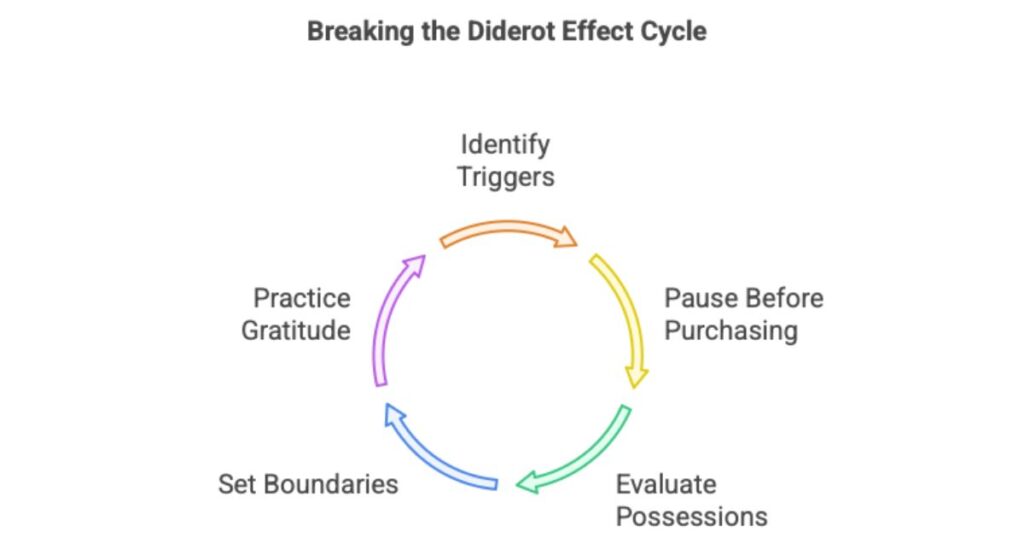Have you ever bought one small thing, and found yourself reaching for another, and another, until your basket held more than you ever planned to carry? Perhaps you replaced your phone, and suddenly the old case looked worn, the charger outdated, the headphones not quite right. This is no accident. It is the quiet pull of the Diderot Effect. One change invites another.. one upgrade demands its companions.
But within this awareness lies power. To pause. To choose. To spend not out of habit, but with intention. And in that pause, you may find not just savings.. but freedom.
Why to Use The Diderot Effect
The Diderot Effect is more than just a fancy term – it’s a powerful lens through which we can understand our buying behaviors. By recognizing this effect, you can:
- Gain control over impulsive purchases
- Make more mindful decisions about your possessions
- Align your spending with your true values and needs
- Reduce clutter and unnecessary expenses
Imagine being able to walk into a store and buy only what you need, without feeling the urge to upgrade everything else in your life. That’s the power of understanding the Diderot Effect!
How to Use The Diderot Effect
- Identify Your Triggers: Pay attention to what sparks your desire for new purchases. Is it a new gadget? A piece of clothing?
- Pause Before Purchasing: When you feel the urge to buy something new, take a moment to reflect. Ask yourself, “Do I really need this, or am I falling into the Diderot Effect trap?”
- Evaluate Your Current Possessions: Before making a new purchase, look at what you already own. Is it still functional? Does it still serve its purpose?
- Set Clear Boundaries: Establish spending limits and stick to them. This helps prevent the spiral of unnecessary purchases.
- Practice Gratitude: Regularly appreciate what you already have. This can reduce the desire for constant upgrades.
Real-life Implementation
Meet Sarah, a young professional who recently moved into her first apartment. She bought a beautiful, modern coffee table for her living room. Suddenly, her old couch looked shabby in comparison. She felt the urge to replace it, along with the rug, curtains, and even the wall art.
Recognizing the Diderot Effect in action, Sarah paused. She evaluated her current possessions and realized her couch was still comfortable and functional. Instead of replacing everything, she decided to simply add a few throw pillows that complemented the new coffee table. This small change refreshed her living room without breaking the bank or cluttering her space with unnecessary items.
By understanding and countering the Diderot Effect, Sarah saved money, reduced potential clutter, and still achieved a cohesive look in her apartment.
Template Framework
Use this simple framework to combat the Diderot Effect in your life:
Identify: What new item am I considering purchasing?
Reflect: Why do I want this item? Is it a need or a want?
Evaluate: What existing items might I feel compelled to replace if I buy this?
Alternatives: Are there smaller changes I can make instead of a full replacement?
Decision: Based on this reflection, should I proceed with the purchase?
History of The Diderot Effect
The Diderot Effect gets its name from Denis Diderot, an 18th-century French philosopher. In 1769, Diderot wrote an essay titled “Regrets on Parting with My Old Dressing Gown,” where he described receiving a beautiful new scarlet robe. This new robe made his other possessions seem shabby in comparison, leading him to replace them one by one.
Diderot’s experience of cascading purchases became known as the Diderot Effect. It wasn’t until the 20th century that this concept gained traction in consumer behavior studies. Today, it’s a valuable tool for understanding our consumption patterns and making more mindful choices about our possessions.
By understanding and applying the Diderot Effect, you can take control of your spending habits and create a more intentional, clutter-free life. Are you ready to harness the power of this tool and transform your relationship with consumption?
Tools You Might Also Like:
- The 2-Minute Rule: A Simple Tool for Greater Productivity
- The Eisenhower Matrix: A Simple Tool for Better Time Management
- The Ivy Lee Method: A Simple Way to Boost Your Productivity
- The 80/20 Rule: Unlocking More with Less Effort
- The Pomodoro Technique: A Simple Tool to Boost Your Productivity
- The Seinfeld Strategy: Building Habits with Consistency
